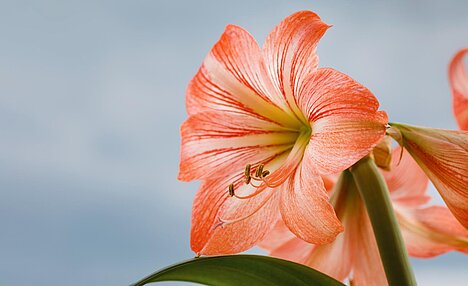Hippeastrum

If you are looking for a plant to decorate your home in winter with its large, colorful flowers, then the delphinium might be a good choice for you. The delphinium, also known as amaryllis, is a bulbous plant from South America that blooms in various colors from white to pink to red. But be careful: the delphinium is not only beautiful, but also very poisonous. In this article, you can find out more about this plant and how you can protect yourself and your pets from poisoning.
What is the delphinium?
The knight's star (Hippeastrum) belongs to the amaryllis family (Amaryllidaceae) and is closely related to the belladonna (Amaryllis belladonna), which is also known as the amaryllis. The two plants look very similar, but have different origins and flowering times. The belladonna comes from South Africa and blooms in the fall, while the delphinium comes from South America and blooms in the winter.
The delphinium has a large bulb from which a thick stem with several funnel-shaped flowers grows. The flowers can be up to 20 cm in diameter and are usually slightly drooping. The color varies from white to pink to red, sometimes also striped or spotted. The leaves of the knight's star are narrow and long and usually grow after flowering.
The delphinium is a popular houseplant that is often bought around Christmas time. It needs a bright spot, but not direct sunlight. It should be watered moderately, but not too wet. After flowering, it should be kept in a slightly cooler place and watered less until it sprouts again in spring.
Why is the delphinium poisonous?
The delphinium is poisonous because it contains various alkaloids that have an effect on the nervous system. Alkaloids are nitrogenous compounds that occur in many plants and often have a bitter taste. They serve plants as protection against predators or as an adaptation to extreme environmental conditions.
The most important alkaloids in the delphinium are amelline and lycorine, which are cytotoxic, i.e. they damage or kill body cells. In addition, the knight's star also contains caranine, acetylcaranine and undulatin, which are also toxic. The highest concentration of these substances is found in the bulb of the delphinium, but all other parts of the plant are also poisonous.
The poisonousness of the delphinium is so high that it was once used as arrow poison. Just a few grams of the bulb can be fatal to humans or animals.
How do you recognize poisoning by the knight's star?
Poisoning by the star of knights can manifest itself through various symptoms, which can vary depending on the quantity and type of plant part consumed.
The most common signs of poisoning are
- increased salivation
- nausea
- vomiting
- diarrhea
- stomach pain
In the case of severe poisoning, the following symptoms may also occur:
- palpitations
- heart problems
- cramps
- trembling
Poisoning by the delphinium can be life-threatening and requires immediate medical attention. If you or someone else has accidentally eaten parts of the delphinium, you should immediately call poison control or go to the hospital. If possible, you should take a sample of the plant or vomit with you to facilitate diagnosis and treatment.
The treatment of poisoning by the star of the knights usually consists of the following measures:
- Giving activated charcoal to bind the poison in the stomach
- Administration of laxatives to remove the poison from the intestine
- Inducing vomiting to remove the poison from the stomach
- Giving infusions and medication to alleviate the symptoms
How can you avoid poisoning by larkspur?
The best way to avoid poisoning by the delphinium is to keep the plant out of the reach of children and pets. Children should be made aware of the danger of the plant and should not be encouraged to play with or eat it. Pets should not have access to the plant and should not be encouraged to chew or nibble on it.
When caring for the delphinium, you should wear gloves and wash your hands thoroughly afterwards. If you repot or divide the bulb, you should make sure that no parts of it are lying around or end up in the trash. If you use the delphinium as a cut flower, you should change the water regularly and make sure that no petals or stamens fall off.
The delphinium is a beautiful plant that provides color and joy in winter. But it is also a dangerous plant that can be deadly for humans and animals. If you decide to plant the delphinium, you should be well informed and careful. Or choose another plant that is just as beautiful but not poisonous.
If you notice any signs of hypersensitivity or poisoning in your dog, you should see your vet immediately. We are not a substitute for a vet, but we try to be as accurate as possible. Every dog reacts differently and we recommend you get a second opinion or consult your vet if in doubt.
Stay healthy and take good care of your four-legged friend!😊